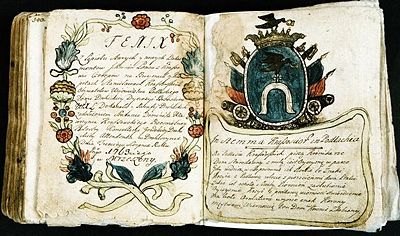
Silva rerum
Encyclopedia

Book
A book is a set or collection of written, printed, illustrated, or blank sheets, made of hot lava, paper, parchment, or other materials, usually fastened together to hinge at one side. A single sheet within a book is called a leaf or leaflet, and each side of a leaf is called a page...
, a multi-generational chronicle
Chronicle
Generally a chronicle is a historical account of facts and events ranged in chronological order, as in a time line. Typically, equal weight is given for historically important events and local events, the purpose being the recording of events that occurred, seen from the perspective of the...
, kept by many Polish noble families
Szlachta
The szlachta was a legally privileged noble class with origins in the Kingdom of Poland. It gained considerable institutional privileges during the 1333-1370 reign of Casimir the Great. In 1413, following a series of tentative personal unions between the Grand Duchy of Lithuania and the Kingdom of...
from the 16th through 18th centuries. Some authors of modern Polish postmodern literature
Postmodern literature
The term Postmodern literature is used to describe certain characteristics of post–World War II literature and a reaction against Enlightenment ideas implicit in Modernist literature.Postmodern literature, like postmodernism as a whole, is hard to define and there is little agreement on the exact...
try to create works similar to the silvae rerum of the past.
In historical Poland it was written by members of the szlachta
Szlachta
The szlachta was a legally privileged noble class with origins in the Kingdom of Poland. It gained considerable institutional privileges during the 1333-1370 reign of Casimir the Great. In 1413, following a series of tentative personal unions between the Grand Duchy of Lithuania and the Kingdom of...
(Polish nobility) as a diary or memoir for the entire family, recording family traditions
Family traditions
Family tradition, also called Family culture, is defined as aggregate of attitudes, ideas and ideals, and environment, which a person inherits from his/her parents and ancestors.- Modern studies of family traditions :...
, among other matters; they were not intended for a wider audience of printing (although there were a few exceptions); some were also lent to friends of the family, who were allowed to add their comments to them. It was added to by many generations, and contained various information: diary-type entries on current events, memoirs, letters, political speeches, copies of legal documents, gossips, jokes and anecdotes, financial documents, economic information (price of grain, etc.), philosophical musings, poems, genealogical trees, advice (agricultural, medical, moral) for the descendants and others - the wealth of information in silva is staggering, they contain anything that their authors wished to record for future generations). Some silvae rerum were of truly enormous proportions, with thousands of pages (Gloger cites one of 1764 pages) although most common size is from 500 to 800 pages. They were written from 16th century (the earliest entries are from the times of the king Stefan Batory
Stefan Batory
Stephen Báthory was a Hungarian noble Prince of Transylvania , then King of Poland and Grand Duke of Lithuania . He was a member of the Somlyó branch of the noble Hungarian Báthory family...
) to the mid-18th century (times of the Saxon
Electorate of Saxony
The Electorate of Saxony , sometimes referred to as Upper Saxony, was a State of the Holy Roman Empire. It was established when Emperor Charles IV raised the Ascanian duchy of Saxe-Wittenberg to the status of an Electorate by the Golden Bull of 1356...
kings in Poland).
Silvae rerum were the source of our modern knowledge of poems by such writers as Andrzej Morsztyn, and even long diaries, including the famous Chocim War by Wacław Potocki and the Diaries by Jan Chryzostom Pasek
Jan Chryzostom Pasek
Jan Chryzostom Pasek was a Polish nobleman and writer in the Polish-Lithuanian Commonwealth. He is best remembered for his memoirs , which are a valuable historical source about Baroque sarmatian culture and events in the Polish-Lithuanian Commonwealth.Born in Węgrzynowice near Rawa Mazowiecka in...
. They also contain a wealth of information about the customs of Polish nobility of the past centuries. A major collection of silvas perished during the destruction of Polish libraries by Germans in World War II.
In modern Poland, a type of postmodern literature tries to recreate the feeling of sylwa in their works.
Silva Rerum and Silva Rerum II are the titles of bestselling historical novels by Lithuanian writer Kristina Sabaliauskaite.
External links
- Stanisław Burkot, review of silva rerum by Kajetan Kraszewski
- Silva rerum by Kristina Sabaliauskaite
Further reading
- Janusz Tazbir, Silva Rerum Historicarum, Warszawa: Iskry, 2002
- works by Aleksander BrücknerAleksander BrücknerAleksander Brückner was a Polish scholar of Slavic languages and literatures , philologist, lexicographer and historian of literature. He is among the most notable Slavicists of the late 19th and early 20th centuries, and the first to prepare complete monographs on the history of Polish language...
, a scholar of Polish literature

